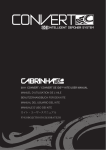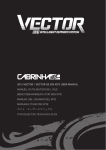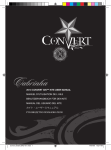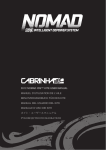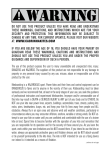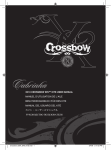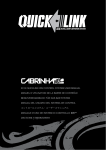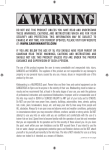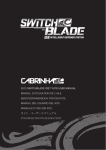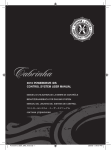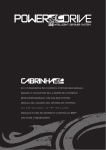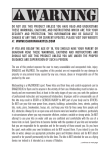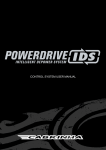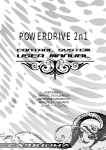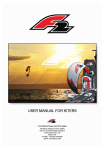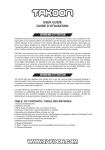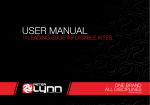Download 2012 drifter ids™ kite user manual manuel d`utilisation
Transcript
2012 DRIFTER IDS™ KITE USER MANUAL MANUEL D'UTILISATION DE L'AILE BENUTZERHANDBUCH FÜR DEN KITE MANUAL DEL USUARIO DEL KITE MANUALE D’USO DEI KITE カイト・ユーザースマニュアル РУКОВОДСТВО ПОЛЬЗОВАТЕЛЯ DO NOT USE THIS PRODUCT UNLESS YOU HAVE READ AND UNDERSTAND THESE WARNINGS, CAUTIONS, AND INSTRUCTIONS WHICH ARE FOR YOUR SECURITY AND PROTECTION. THIS INFORMATION MAY BE SUBJECT TO CHANGE AT ANY TIME. FOR CURRENT UPDATES, PLEASE VISIT OUR WEBSITE AT: WWW.CABRINHAKITES.COM IF YOU ARE BELOW THE AGE OF 18, YOU SHOULD HAVE YOUR PARENT OR GUARDIAN READ THESE WARNINGS, CAUTIONS AND INSTRUCTIONS AND SHOULD NOT USE THIS PRODUCT UNLESS YOU ARE UNDER THE PROPER GUIDANCE AND SUPERVISION OF SUCH A PERSON. The use of this product exposes the user to many unavoidable and unexpected risks, injury, DANGERS and HAZARDS. The suppliers of this product are not responsible for any damage to property or any personal injury caused by any use, misuse, abuse or irresponsible use of this product by the user. Kiteboarding is a HAZARDOUS sport. Power kites and their lines and control equipment can be DANGEROUS to flyers and to anyone in the vicinity of their use. Kiteboarding must be taken seriously and we recommend that, at least in the early stages of your use, you seek the guidance of professional instructors and experienced kiteboarders. Improper and/or unreasonable use of this kite may result in DEATH or SERIOUS INJURY to ANY part of your body and to OTHERS. Do NOT use your kite near power lines, airports, buildings, automobiles, trees, streets, parking lots, rocks, piers, breakwaters, buoys, etc. and keep your kite fly lines away from people and ALL obstacles. Always fly in an open area and observe wind and weather conditions, particularly in circumstances where you may encounter offshore, onshore, variable or strong winds. Do NOT attempt to use your kite on water until you are confident and comfortable with the use of a trainer kite on land. Spend time to become familiar with the operation of your kite and remember that you are responsible for its operation and for the security of those around you. As you learn the sport, work within your own limitations and do NOT exceed them. If you intend to use the kite on water, always use appropriate protective gears and flotation devices and do NOT attach yourself or tie yourself permanently to the kite lines. The kite is NOT intended for use as a flying device nor indeed is it intended as a means of flotation. ...continues to next page continued from previous page... RECOMMENDED KITEBOARDING PRACTICE: Kiteboarding is an extremely diverse sport, with many disciplines and ability levels. As with all sports, there can be certain inherent risks. The following contains key security points to remember when operating your Cabrinha kite. • KiteboardingisaHAZARDOUSactivityandtheuseofKiteboardingequipmentinvolvestherisk ofseriouspersonalinjurytoanypartoftheuser’sbodyordeath. • InjuriesareanINHERENTRISKofkiteboardingandtheparticipationinkiteboardingimpliesthe user’sacceptanceandassumptionofthoserisks. • ChildrenshouldALWAYSbeunderadultsupervision. • Itisstronglyrecommendedthatbeginnerstakelessons. • ALWAYSinspectyourequipmentforsignsofwearandteareachtimebeforeuse,particularly alllines,canopy,bladders,screwsandfittings. • IfANYproductsarefoundtoshowsignsofwear&tear,STOPusingtheproductimmediately andrepairorreplacebeforefurtheruse.Ifindoubtaboutanysignsofwear&tear,please contactyourlocalvendor.Contactdetailsareavailablefromwww.cabrinhakites.com • NEVERplaceyourselfinasituationwherebreakageofanyoneofthevariouskiteboarding componentswouldposearisktoyourselforothers,ormakeitdifficulttoreturntotheshore securely&unassisted. • Makesureyouuseproperlydesignedandmanufacturedpartsfromreputablesuppliers. • Taketimetostudytheconditionsincludingseastate,tides,currents,weatherconditionsand forecastsbeforeyoudecidetogosailing.Bewareofsailinginoffshore,onshore,variableor strongwinds. • Familiarizeyourselfwithanynewlocationbeforeventuringontothewater.Askthelocalstotell youaboutanyhazards. • Watchoutforotherbeachusers,especiallyswimmersandsmallchildren.Makesureyoukeep yourboardandrigundercontrolatalltimesandthattheydon’tgetblownaboutonthebeach orinthewater. • Alwaysuseappropriateprotectivegearandflotationdevices.Wearthecorrectprotectiveclothing fortheconditionssuchasawetsuitoraUVtop. • WeSTRONGLYrecommendwearingakiteboardingspecifichelmet • Makesuresomeoneknowswhereyou’vegone&whenyouareexpectedback–alwayssail withabuddy. • Beawareoftheconditionsastheychange.ALWAYSreturntothebeachifthereisasignificant changeintheconditions.i.e.winddroppingorwind&wavesincreasing. • Asyoulearnthesport,workwithinyourownlimitationsanddoNOTexceedthem. • DoNOTalter,modifyorchangethisproduct. • Thisproductisdesignedandmanufacturedonlyforkiteboardingonwaterorsnow. • Keepthesewarnings,cautionsandinstructionsforfuturereference. • ThefollowingcontainskeysecuritypointstorememberwhenoperatingyourCabrinhakite,and associatedkiteboardingequipmentonwater,landorsnow. SNOw USE GENERAl GUIDElINES • ThepointslistedundertheRecommendedKiteboardingPracticealsoapplytotheuseofthis productonthesnow.Pleasereadthepreviousparagraphsevenifyouintendtousethis productprimarilyonthesnow. • Thesekitesareintendedforuseonthesnowasatractiondevicetopropelarideracrosswide opensnowfieldsinacontrolledandappropriatemanner. • DoNOTattempttousethiskiteasaflyingdevice.DoNOTusethiskitetosoarfromridges, cliffsorslopes. • DoNOTattempttolaunchyourselfintotheairinanymannerwhichcancreateexcessive impacttotherideruponlanding. • EXTREMEcautionmustbetakenwhenusingthiskiteinanymountainousregion,uneventerrain orglacier.Windconditionsintheseareasarenotoriouslyunstableandcanchangeinvelocity anddirectionwithoutnotice. • ALWAYSuseappropriateprotectivegear.WeSTRONGLYrecommendwearinga snowboardingspecifichelmet. • DoNOTtetheryourselftoanystationaryormovingobjectsuchasastake,snowmobile,or carwhileflyingthiskite. • ALWAYSstayincontrolandbeabletostoporavoidotherpeopleorobjects • SNOWKITE:Peopledownwindordownslopehaverightofway.Itisyourresponsibilityto avoidthem • SNOWBOARD:Peopledownslopehaverightofway.Itisyourresponsibilitytoavoidthem • YoumustNOTstopwhereyouobstructothersorarenotvisible. • Wheneverstartingormergingwithotherslookupwind/uphillandyieldtoothers. • Alwaysuseretentiondeviceswhileridingtohelppreventrunawayequipment.Ifyouremove heretentiondeviceforanyreason,turnsnowboardupsidedownandpushthebindingsinto thesnowtopreventrunaways. • Observeanyandallpostedsignsandwarnings • Keepoutofclosedareas • SNOWBOARD:Priortousinganyliftyoumusthavetheknowledgeandabilitytoload,ride andunloadsafely. • DoNOTsnowboard/snowkitewhentiredorundertheinfluenceofalcoholordrugs. • Snowterrainandsnowboarding/snowkitingconditionsVARYCONSTANTLY--AVOIDANY manmadestructures,trees,tree-wells,rocks,debris,variationsinterrainorslopes,avalanche areas,crevasse,cliffs,powerlines,liftlines,waterhazards,changesinsnowsurfacesor textureduetoaltitudeandsunexposure,windandweatherchanges,andanyotherconditions whichcouldaffectyourabilitytoproperlycontrolyoursnowboard/snowkite. CONTENTS 2 3 4 4 5 6 7 8 9 Introduction ImportantInformation Wind,Water,&WeatherConditions WindRangeChart KnowYourAbilityLevel/KiteboardingLocation KiteCare BeachEtiquette AreaofOperation KitePositions,Zone&Power KITE OVERVIEW & CONTROL SYSTEM 10 2012DRIFTERIDS™Overview SETUP 11 Sprint™InflationSystem 12 InflatingtheKite 14 Pause HOW TO 15 Repairs-Tears/StrutsBladders 17 Repairs-LeadingEdgeBladders 19 Glossary 2012DRIFTERIDS™KITEUSERMANUAL 1 INTRODUCTION ThankyouforpurchasingthisCabrinhaproductandwelcometothesportofkiteboarding.As youmayknow,theexcitementofKiteboardingisattractingpeopleofallagesfromallcorners oftheglobe.It’soneofthemostdynamicandfastestgrowingsportsintheworld. CAUTION: Kiteboarding can be overwhelming if not approached in an educated manner. That’s why we have supplied this extensive user’s manual. It will help to educate you about your new kite and about the ways in which to use it. It contains information regarding the setup, care and maintenance of your control system. Please note that only compatible Cabrinha kites will benefit from all of the security and performance functions associated with this control system. Consult www.cabrinhakites.com for a list of compatible Control Systems for use with this kite. Pleasereadthisuser’smanualcarefullyandentirelybeforeusingthiskite.Thismanualisnot intendedtoreplaceproperkiteboardinginstruction,butrathertosupplementit.Donotattempt tokiteboardwithoutappropriateinstruction.Itwillmakethissportmoreenjoyable,notonlyfor yourself,butforthosearoundyou. 2 2012DRIFTERIDS™KITEUSERMANUAL IMPORTANT INFORMATION Kiteboarding is a hazardous sport, with many disciplines and ability levels. As with all sports, there are inherent risks of injury. The following contains key points to remember when operating your Cabrinha kite. • Befamiliarwiththesetupanduseofthesuppliedsecuritysystems:IDS™andtheHarness LoopQuickReleasesystems. • Makesureyourcontrolsystemisriggedandusedaccordingtothesuppliedinstructions. • Makesureyourkiteiscompatiblewiththecontrolsystem. • AlwaysuseyourCabrinhakitewithabypassleash. • NEVERpermanentlyattachyourselftothiskite,thecontrolbar,orlines. • NEVERusethiskiteasaflyingdevice. • NEVERtouchthekitelineswhiletheyareundertension;donotcatchthekiteusingthese lines. • Wheninflatedbutnotinuse,secureyourkitewithsandorwithsomethingheavyandnonabrasive;themoreweightthebetter(see“KiteCare”formoreinformation).Aninflatable powerkitewillstillfly,evenwithoutarider,sobemindfulofthosearoundyouandsecure yourkite.Yourkitemaycauseseriousinjuryordeathifitlaunchesunexpectedly. • Donotlendyourgeartosomeonewhohasnotbeenfullyinstructedontheuseofinflatable kites.Otherusersshouldalsoreadthisuser’smanualandbeproficientinallitspoints. • Checkyourgearbeforegoingonthewater.Insurethatyourflyinglines,securitysystems, kite,board,etc.areallriggedproperlyandareinworkingorder. PROTECTIVE GEAR Westronglyrecommendtheuseofthefollowingprotectivegear: • Kiteboardingspecifichelmet • LifeJacket,ImpactVest,orFlotationVest • NeopreneWetSuit • Gloves • FootProtection • EyeProtection • Knife • Sunscreen 2012DRIFTERIDS™KITEUSERMANUAL 3 IMPORTANT INFORMATION WIND, WATER, AND WEATHER CONDITIONS • • • • • • • • • • • • DoNOTunderestimatethepowerofthewind. Beawareofunpredictableandchangingweatherconditions. Avoid“offshore”or“onshore”windconditions. Avoidstrong,gustywind. Becarefulofwaveconditions,especiallywhenlearning. Beeducatedabouttidesandripcurrents. Bemindfulofyourabilitylevel.DoNOTkiteboardifconditionsarebeyondyourabilitylevel. Beeducatedaboutairandwatertemperaturesandwearappropriateprotectionagainstthe elements. DoNOTusethisproductinthunderstorms. Consultananemometerandweatherstationstodeterminewindspeedsifnecessary. DoNOTuseanoversizedkite.ConsultyourWindRangeChartforthecorrectrecommended size.Useyourcommonsense.Ifindoubtaboutwhatkitesizetouse,choosesmallerrather thanbigger. MakecertainthatyouarephysicallycapableofoperatingthesecurityQuickRelease(QR) andIDS™devicesprovidedwiththiskite.Thiskiteandcontrolsystemhasbeendesigned aroundatypicalriderweightof75kg(165lbs). Riderswithaweightgreaterthan75kgmayneedtousemoreforcetooperatetheQRthanlighter riders.IncreasesinwindstrengthmayalsoresultingreaterforcebeingrequiredtooperatetheQR. BecertaintoseektheadviceofaprofessionalsuchasyourAuthorizedCabrinhaDealeraboutthe performanceofthesecuritysystemsinrelationtobodyweight. WIND RANGE CHART Thiswindrangechartisonlytobeusedasapointofreference.Itisbaseduponariderwhois approximately75kg(165lbs).Actualusemayvarybasedonyourbodyweight,abilitylevel,water conditions,boardsize,andridingstyle.Whenchoosingakitesize,pleaseuseyourpersonalexperience,commonsense,andalwayscheckwhatotherridersareusingonthewaterforasize reference.Lighterridersshoulduseasmallerkiteandheavierridersmayneedasizelarger.Be certaintoseektheadviceofaprofessionalsuchasaninstructororAuthorizedCabrinhaDealer beforemakingyourdecision. 4 2012DRIFTERIDS™KITEUSERMANUAL IMPORTANT INFORMATION KNOW YOUR ABILITY LEVEL KITEBOARDING LOCATION • Do NOT attempt kiteboarding without appropriateinstruction. • ObserveALLlocallawsandregulationsregardingthisproductandtheusagearea. • DoNOTkitealone. • Talk to the local riders about the weather conditionsandbeachrules. • Launch,land,andridetogetherwithapartner orhavesomeoneonshorewhocankeepan eyeonyou. • Checkyourareathoroughlybeforelaunchingyourkite. • Makesureyouareingoodphysicalcondition beforeusingthisproduct. • Make sure you have considerable space in whichtolaunch,land,andusethisproduct. • Practice flying a small, traction kite or a “trainerkite”beforeflyingthiskite. • You should have at least 100 meters of space from all objects on both sides and downwind of you. Be especially aware of yourdownwindarea. • The more time spent on the “trainer kite”, thefasteryouwilllearn. • Makesureyouareaproficientswimmerbeforeusingthisproductinornearthewater. • Make sure the wind and water conditions are within your ability level and that you havemadethecorrectequipmentchoices. • NEVER kiteboard further from shore than youarereasonablyabletoswimback. • ALWAYS save a reserve of energy; end your kiteboarding session before you are exhausted. • Makesureyou’vedoneyourhomeworkand that you know the security precautions of allaspectsofthesport:rigging,Launching, landing,flying,riding,kitingamongotherwaterusers,selfrescuing,etc. • Understandandpracticeoperatingyoursecurity systems before ever launching your kite. • Understandthetechniqueofself-rescuebeforeusingthisproductinornearthewater. • NEVERletsomeonewhoisnotfamiliarwith inflatable kites launch, catch, or use your kite. You will endanger them, as well as yourselfandthosearoundyou. • Bemindfulandawareofthewinddirection inrelationtoyourlauncharea. • Avoid areas with rocks and/or shallow or exposedreefs. • Bemindfuloftidechanges.Aswaterlevels change, you may be exposed to new obstructions. • Avoidlaunching,landingorusingthisproduct near power lines, telephone poles, trees,people,pets,buildings,automobiles, streets,sharpobjectsandairports. • Avoidcrowdedbeachesandwaterways. • Makesureyourlinesdonotcrossawalkwayorpassage. • DoNOTletotherswalkbetweenyouand yourkite. • Be careful and mindful of other water users,includingwindsurfers,boaters,jetskiers,swimmers,floatingobjects,etc. • Before launching, make sure you have scoutedabackuplandingarea,incaseyou donotmakeitbacktoyourlaunchspot. • Youareresponsiblefortheproperoperation ofyourkite. 2012DRIFTERIDS™KITEUSERMANUAL 5 IMPORTANT INFORMATION KITE CARE Due to the often extreme nature of kiteboarding, a thorough approach should be taken when caring for your kite and all its associated rigging, as well as your protective gear. PREPARING FOR YOUR SESSION • Thoroughly check your protective equipment (helmet, etc.) to make sure it is in workingorderandingoodcondition. • A frequent inspection of the kite and the controlsystemshouldbemadeinorderto identify punctures, tears, or abrasions in the canopy, struts, or security systems. It isalsonecessarytochecktheflylinesfor wearandforunwantedknots,whichmay reducethestrengthoftheflylines.Check bridlelinesandpulleysforwearandreplace whennecessary. • Do NOT rig on asphalt, cement, gravel, or other abrasive surfaces; doing so may damage your equipment. It is best to rig on sand or grass. Damage done to your equipmentbyriggingonabrasivesurfaces willnotbecoveredunderwarranty. erties of the material and reduce it’s longevity.Ifyoumustleavethekiteexposedto thewindonthebeach,placesandorsand bags onto the areas of the kite, near the trailingedgeuntiltheflutterisstabilized.Do notuserocksorothersharpobjects. • Do NOT leave your kite exposed to sunlight for long periods of time. Between sessions,chooseashadedareatosecure yourkite.Whennotinuse,stowaway. PROPER STORAGE • ALWAYS dry your kite prior to rolling or folding.Foldingorrollingakitewhenwet mayaffectthecolorclarityandlongevity. • Itisrecommendedtowashthekitecomponents with fresh water and dry before storing. • DoNOTrigamongsharpobjectsthatcould tearthecanopyorpuncturethestrutsand leadingedgebladder. • Clearthekiteofsandorotherforeignobjectsbeforestowing. • TakecareNOTtoexposeyourflyinglines to sharp objects that may wear through them. • Once it is clean and dry, stow your kite in the supplied bag in a clean, dry, cool place. • While setting up, secure your kite with sandorsandbags.DoNOTsecureyour kite with rocks or other sharp or abrasive objectsthatmaydamageyourkite. • Do NOT place heavy objects on the bag containingthekite. BETWEEN SESSIONS • NEVER leave an inflated kite unattended on the beach for a long period of time. Winds may shift or change and the kite maybecomeunsecuredandflyoff. • DoNOTleaveaninflatedkite(securedor not) directly exposed to the wind for any lengthoftime.Thisallowsthetrailingedge toflutterexcessively.Anyexcessiveflutteringmayquicklybreakdownthefinishprop- 6 • Do NOT leave your kite inflated in your car or car rack box; exposing the kite to extreme temperatures while inflated may damagetheinternalbladders. • Washyourcontrolsystemwithfreshwater fromtimetotimebyplacingtheentirecontrolsystem(withlineswoundontothebar) intoabucketoffreshwaterandletitsitfor 5minutes.Allowtodrythoroughlybefore storinginadrylocation. • Onceitiscleananddry,stowyourcontrol systeminaclean,drycoolplace. 2012DRIFTERIDS™KITEUSERMANUAL BEACh ETIqUETTE Here are some basic things to consider when sharing beaches and water accesses with other users: SAFETY • FollowALLoftheinstructionsoutlinedinthismanual,othermanualsandinstallationguides. • Followtheinstructionsandrulesandregulationspostedatthebeachesyouuse. • Checkwithlocalkiteboardingassociationsandshopspriortolaunchinginanewarea.There maybelocalrulesandregulationstofollowwhicharenotposted. • Utilizecommonsense. • DoNOTtouchotherpeople’sgear,unlessinstructedtodosobytheowner.Pickinguptheir bars,kites,etc.maydisruptasetupritualtheyhave. • ALWAYSsecureyourkitewithsandorsandbags.Anunmannedkiteisdangerous. • NEVER leave an inflated kite unattended. Winds may shift and cause the kite to become unsecuredandflyoff. SETTING UP • Setuponlythegearthatyouplanonusingimmediately.Deflateandputawayyourkiteswhen notinuse. • Setupinanareawhereyouhaveplentyofspace. • Setupinamannerconducivetohavingmultipleusersinthearea. • Rollupyourlineswhennotinuse. • ALWAYSkeepotherbeachandwateraccessusersinmindwhenlaunching,landing,and kiteboarding. • Yieldtootherbeachusers.Becourteousandcooperative. • ALWAYSbereadytolendassistancetootherkiteboarders.Thefavormaybereturnedsooner thanyouthink. 2012DRIFTERIDS™KITEUSERMANUAL 7 IMPORTANT INFORMATION AREA OF OPERATION Thisisthe100metersofareawithnoobstaclestoeachsideanddownwindoftherider.Donot launchyourkiteifyoudonothavethisdistancebetweenyourselfandotherpeople,orobstructions. PLANNING YOUR LAUNCH • Chooseanareawhereyouhaveatleast100metersofspacefromallobstaclestoyourleft andrightandespeciallydownwindofyou. • Setupyourequipmentsothatyourkiteisdownwindofwhereyouwillbelaunching,butmost importantly,sothatitisatanangleoffofthewind. • DO NOT SET UP YOUR KITE FOR A STRAIGHT DOWNWIND LAUNCH! The kite will launchwithtoomuchpowerandyouwillendangerthelivesofyourselfandthosearoundyou ifyoulaunchinthismanner. • Basically,ifthewindisatyourback,andstraightdownwindisata180°,thenyouwillwantto setyourkiteatabouta100°offthewind,eithertotheleftortotherightofyou. • Themorethekiteispositionedintothewindwhenyoulaunch,thelesspoweritwillhavewhen itgoesup,andtheeasieryourlaunchwillbe. • Yourpartnerwillstandwiththekitewhileyouwillstand30metersawayatyourcontrolbar. • Make sure you launch slowly, and launch the kite at an angle, NOT STRAIGHT DOWNWIND! POTENTIALLY HAZARDOUS: DO NOT SET YOUR KITE FOR A STRAIGHT DOWNWIND LAUNCH. SAFER SAFER RIDER 8 2012DRIFTERIDS™KITEUSERMANUAL IMPORTANT INFORMATION POwER ZONES KITE POSITIONS, ZONE & POWER Itisimportanttounderstandkiteboarding’sbasic zones of power before you launch a kite. Kiteboardingaccidentscanhappenoverlandwhen kiteboardersputtheirkitesinwhatiscalledneutralposition.Peoplethinkthatthekiteisstable in neutral position. However, wind fluctuates-it gustsandlulls-andinneutralposition,something known as lofting can occur when wind fluctuates. When a kite luffs (or receives less wind initsfoil),thekitewillmove slightly away from the pilot. When a gust hits, the kite receives a surge of power, and often that surge of power istoomuchforakiteboarderstandingwiththe kitehighoverhead.Asaresult,thekiteboarder maybelofted(lifted)intotheair.Loftingcanbe serious,butyoumayreducethechancesoflofting by understanding the power zones, and by avoidingputtingyourkiteintheneutralposition whileonland. Neutral Position–Thisisthepositionjustabove thepilot’sheadinthesky.Ifthepilotlevelsoutthe bar,thekitewillgravitatetotheneutralposition. However,itisdifficulttokeepthekiteinthisposition.Althoughinthispositionthekitemayfeel steadyandmayfeellikeithastheleastamount ofpowerorpull,itisalsothepositioninwhich onlandthepilotismostsusceptibletolofting. On the water, the neutral position can be utilizedtorestwhileyoureelinyourboard,buton land,westronglysuggestyoudoNOTutilize theneutralposition.Afterlaunching,itisbest tomakeyourwaytothewaterwithoutdelay.Do NOTlingeronlandwiththekiteinneutralposition–thiscouldbepotentiallyhazardous. Lofting–Loftingoccurswhenthekiteisabove theridersheadintheneutralposition.Instability inthewindcancausesuddenverticalforceand liftarideroffoftheirfeet. Neutral Zone–Thisistheareathatincludes theneutralpositionandtheareatotheleftand rightofthepilot.Itencompassesthemostupwind or windward positions in which to fly the kite.Whenflownhere,thekitehaslesspower orpullthanwhenitisinthepowerzone.However,usecautionwhenthekiteisinthiszone, especiallywhenonland,andespeciallyingusty windconditions. Power Zone–Thisistheareainfrontandto thesidesofthepilot,butexcludingtheneutral positionandzones.Itistheareainwhichthe kitehasthemostpowerandpull.Whenflown inthisarea,thekitecanbepowerfulandharder tocontrol,soavoidflyingyourkiteinthiszone whenlearning.Useextremecautionwhenflying thekiteinthiszone. 2012DRIFTERIDS™KITEUSERMANUAL 9 OvERvIEw 2012 DRIFTER IDS™ 1. 2. 3. 4. 5. 6. 7. 8. KiteBody LeadingEdge Airlock™HighVolumeValve Sprint™Valves Sprint™AirDistributionTube Sprint™AirClips Bridle Pulleys 2 9. BridleGuides 10.Frontlineattachmentpoint point 11.Rearlineattachmentpoint 12.Front(center)Lines 13.Steering(rear)Lines 6 5 1 3 7 8 7 8 8 8 9 9 *imagenottoscale 11 10 11 10 10 13 4 12 12 2012DRIFTERIDS™KITEUSERMANUAL 13 SETUP SPRINT™ INFLATION SYSTEM TheSPRINT™inflationsystemisasimpletousefeaturetoquicklyinflateyourkitetoaneven pressure.TheSPRINT™systemusesasingleinflationpointtoconnectyourhighvolume,two wayCabrinhapump.Asyoupumpyourkitewithair,allstrutsandyourleadingedgeinflate quicklyandsimultaneouslytothedesiredpressure.Thesuppliedleashpumpandthreaded valveconnectionkeepsyourkiteundercontrolevenwhenpumpingupdirectlyinthewind. Oncethekiteispumpedyoucanchoosetoclipofftheairtothestruts.Thiswayifyoudamage astrutwhileinuse,therestofthekitewillmaintainitspressure.Attheendofthesessionyou canchoosetodeflateyourkitecompletelybydisengagingthestrutclips. Youcanalsokeepyourstrutsinflatedandputyourkiteawayrolledupsothatthenextsession willtakejustminutestosetup. SINGLE INFLATION VALVE FILLS THE ENTIRE KITE WITH AIR AIRLOCK™ INFLATION/DEFLATION VALVE THEUPPERSECTIONIS THEINFLATIONCAP THELOWERSECTIONIS THERELEASEVALVE FIG. 3 FIG. 2 FIG. 1 2012DRIFTERIDS™KITEUSERMANUAL 11 SETUP INFLATION BASICS SeethesectiononKiteCarebeforeinflatingyourkite. •Unrollyourkitewiththestrutsfacingup. • Makesureyourbackistothewindandthattheleadingedgeofthekiteisclosesttoyourbody. Securethekitewithsandtokeepitfromflappinginthewind. •Usethesuppliedpumpleashtoconnectthepumptothekite.Thiswillfreeyourhandsto pumpthekite. • Opentheinflationcapbyturningitcounter-clockwise.(FIG.1) • Makesurethatthereleasevalveisseatedfirmlybyturningclockwise.Donotovertightenthe releasevalvewhenthekiteisnotinflated.Doingsomaytwistanddamagethebladder.The valvebaseisheldinplacebyaVelcrodisc • AttachthepumpusingthesuppliedCabrinhaadapter(oruseastandardnozzle).Toattachthe adapter,removetheadapterfromtheendofthepumphose.Threadtheadapterontothe uppersectionoftheAirlock™.Reattachthehoseandpumpthekite.(FIG.2) • OpenalloftheAirClipstoallowairtoflowfromtheLEintothestruts.(FIG.3) • Wheninflating,holdthepumpwithbothhandsandprovideevenpressuretothehandle.This willhelpmaintainthelifeofthePump. • Confirmthatthecornersofeachstrutundertheleadingedgeareabletofullyinflate.Lightly pushairaroundinthebladdersuntilthecornersarefreeandcorrectlylinedup. •ItiscommonthattheLEwillinflatebeforethestruts.Ifastrutisnotinflating,makesurethat theairclipisopenandtheairtubeisnotpinchedordamaged. FIG. A • Whenthekiteisfullyinflated,removepumphoseandscrew theinflationcapbackon.Lightlyturn/tightenuntilinflationcap isfirmlysecured. • Tightenthelowerreleasevalve. PROPERLY-INFLATED KITE • Do not under-inflate or over-inflate the kite. Proper inflation willmakeitdifficultbutnotimpossibletobendtheendsofthe kitein.Ifitisveryeasytobendthewingtipsin,theleading edgeisunder-inflated.Yourkiteshouldbefirmenoughthat whileonitsback,thewingtipsshouldextendintotheairand thekiteshouldretainitsbowedshape.(FIG.A)Iftheleading edgeisunder-inflated,itmaycausepoorperformanceandrelaunchingproblems.Allkiteshavebeentestedusing450mB pressure.NOTE:Thepumpsareratedto1barofpressure, howeverduetowearandtear;pumpscanfailatamuchlower pressure. •Itisrecommendedthatyouisolatetheairinyourstruts.After thekiteisinflated,closetheclipsontheairdistributiontubes. UNDER-INFLATED KITE 12 • Oncethekiteisproperlyinflated,turnthekiteoverandsecure withsand.(seeSETUPTIPSONSECURINGYOURKITE) 2012DRIFTERIDS™KITEUSERMANUAL SETUP TIPS FOR SECURING YOUR KITE • • • • • • Neverleaveaninflatedkiteunattendedonthebeach foralongperiodoftime.Windsmayshiftorchange andthekitemaybecomeunsecuredandflyoff. Alwayssecureyourkitewithsand,usingmoreweight thanyouthinkyouneed.Anunmannedkiteisdangerous. Never secure your kite with rocks or sharp objects (includingyourboard);theywillcompromisethelifeof the kite. If you do not have a sandy beach launch, considersandbags. Donotleaveaninflatedkite(securedornot),directly exposedtothewindforanylengthoftime.Thisallows thetrailingedgetoflutterexcessively,whichcandamage thekiteortanglethecontrollines.Ifyoumustleave thekiteexposedtothewindonthebeach,placesufficient amountsofsandbetweeneachstrutandnearthetrailing edgetominimizeorstopthefluttering.Also,ifpossible, leavethekiteinashadedarea. Keepinmindotherbeachusersandmakesureyour kiteandlineswillnotbeadangertoothers. Windyourlinesontothebarwhenyouarenotkiting. Thiswillkeepthebeachfreeoflinesandwillprevent other beach users from becoming tangled in your equipment. TO DEFLATE UNSCREW RELEASE VALVE. FIG. A DEFLATING THE KITE Thekitemaybedeflatedcompletelyorpartiallyforyour convenience.TodeflateonlytheLeadingEdge,youmust besurethatalltheSPRINT™airclipsarepinchedclosed, thereby isolating each individual strut. Next, unscrew the releasevalveandnottheinflationcap.Thereleasevalveis thelowerportionoftheAIRLOCK.(FIG.A)Afterdeflating, rollupeachendofthekitestartingatawingtipandmoving towardsthecenter.Clearthevalveofanysandordebris; then seal the valve before stowing kite to prevent debris from getting inside internal bladder. To deflate the entire kite, unclip the air clips at each strut. Then unscrew the releasevalve.Thiswillallowalltheairtoflowthroughthe leadingedgeandoutoftheairlock. CAUTION: Whenclosingvalveonadeflatedkite,holdbladder inplacetopreventtwistingthebladder.Donotover tightenvalvewhenkiteisdeflated.Youmaytighten itfurtherwhenkiteispartiallyinflatedagain. 2012DRIFTERIDS™KITEUSERMANUAL 13 IMPORTANT! PAUSE! FOR SETUP OF YOUR CABRINHA CONTROL SYSTEM, REFER TO YOUR SUPPLIED CONTROL SYSTEM MANUAL. IF YOU ARE UNSURE AS TO WHICH CONTROL SYSTEMS ARE COMPATIBLE WITH THIS KITE, PLEASE REFER TO THE KITE/CONTROL SYSTEM COMPATIBILITY CHART AVAILABLE ONLINE AT WWW. CABRINHAKITES.COM. 14 2012DRIFTERIDS™KITEUSERMANUAL REPAIRS MAjOR TEARS Foramajortearinthekitefabric,consultyourdealerforareputablekiterepairloft.Tofinda Cabrinhadealerinyourarea,pleasegoto:http://www.cabrinhakites.com/where_to_buy/dealer.html MINOR TEARS Foraminortearinthekitefabric,youmayrepairthetear withkiterepairtape.Yourkitehasbeensuppliedwithan adhesivekiterepairmaterial. 1. 2. 3. 4. 5. 6. Cleananddryyourkite. Laythekiteflatonaclean,dry,smoothsurface. Cuttwopiecesofrepairtapethesamesize,makingsure theyareeachbigenoughtocovertheentiretear. Carefullycoveronesideofthetearwithapieceofthe repairtape.Gentlyrubthetapesmoothlyontothesur faceofthekite. Next,covertheoppositesideofthetearwiththesecond pieceofrepairtape,inthesamemannerasbefore. Makesurethetapeissecure. FIG. 1 FIG. 2 REPAIRING STRUT BLADDERS Key Points to Remember • Before attempting to repair one of your kite bladders, make sure your kite is clean and dry. Always keep your kite pump, valves and bladders free of sand, water and other things that will dirtythem. • Makesurethebladdersaredeflated. • Avoidrepairingyourkiteonthebeachorindirty,dusty, windy,orabrasiveareas.Itisbesttofindaclean,dry spotoutofthewind.Agrassyspotisideal. • Youwillneedasetofflyinglinesandabladderrepairkit (suppliedwithkite)beforeyoubegintorepairthebladder. • Keeptrackofallvalvepartsforlateruse. 1. First,laythekiteoutflatwiththestrutsfacingup. 2. DetachtheVelcroclosureattheendofthedamaged strut.Thiswillopenupthesleeveofthestrutandwill allowyouaccesstotheinternalbladder.(Fig.1) 3. Next,separatetheSprint™inflationtubefromtheLE Sprint™valveattheaffectedstrutbyremovingthetubing lockcollar(LEvalve)(Fig.3). 4. Slidetheairclipoffofthetube(Fig.4). 5. Removethescrews(2)fromthebaseofthestrutvalve (Fig.5).Keeptrackofthevalvepartsforlateruse. 6.Tieoneflyinglinearoundthevalve.Cinchitdownwell onthevalve. 7.Gentlyinsertthevalve/tubedownintothestrutsleeve. FIG. 3 FIG. 4 FIG. 5 2012DRIFTERIDS™KITEUSERMANUAL 15 REPAIRS REPAIRING STRUT BLADDERS (continued) 8. Gotothebaseofthesleeveandgentlypullthebladder outofthesleeve.Detachtheflyinglineandleaveitin FIG. 6 thesleeve.Havingtheflyinglinethroughthesleevewill allow you to easily replace the bladder once it is repaired. 9. Slidetheairclipbackontotheinflationtube.Inflatethe bladderandclampthetubingsothatitmaintainsair.Do notoverinflatethebladder. 10. Submergethebladderinwatertolocatethehole.A bathtuborlargesinkfullofwaterisbest. FIG. 7 11. Lookforbubblestolocatethehole. 12. Onceyouhavelocatedtheleak,drytheareaandmark theholewithacircle.Apermanentmarkerworksbest forthis.(FIG.6) 13. Dryandcleantherestofthebladderwithasofttowel. 14. Again,deflatethebladder. 15. Decidewhethertousetheglueorapatchsuppliedin yourbladderrepairkit. 16. Iftheholeisonaseam,youwillneedtogluethearea. 17. Iftheholeisonaflatareaofthebladder,removethebackingononeofthepatchesandpress itontothebladder,coveringthehole. 18. Setthebladderasideforapproximately20minutestodry. 19. Again,inflatethebladderandchecktomakesureitisnowholdingair. 20. Ifyouhaverepairedtheholesinthebladder,coattheentirebladderintalcumpowdertoassist insertionbackintothesleeve.(OPTIONAL) 21. Deflateonceagain. 22. Tietheflyinglinefromtheendofthestrutopeningontothevalve. 23. Laythebladderflatattheendofthestrut,sothatyoumaynowfeeditbackintothesleeve. 24. Gentlyfeedthevalve,followedbytherestofthebladder,intothesleeve. 25. Fromthevalveopeningofthesleeve,youwillpulltheflyinglineoutofthesleeve,whilepulling thebladderbackintoplace. 26. Oncethebladderisreplaced,pullthevalvebackintotheholeofthesleeveandremovethe flyinglinefromitsbase.(FIG.7) 27.ReplacetheSprintbasecollarandtightenthescrewsaccordingly. 28. Inflatethestrutpartiallytomakesurethebladderfitsintoallfourcornersofthesleeve. 29.AttachtheAirDistributiontubeandclipconnectedtotheLE. 16 2012DRIFTERIDS™KITEUSERMANUAL REPAIRS REPAIRING LEADING EDGE BLADDERS FIG. 1 1. First,laythekiteoutwiththestrutsfacingup. 2. EachendoftheLeadingEdge(LE)bladderisfoldedover andsecuredwithaVelcroclosure.Youwillalsofindazipper accesspocketatthecenteroftheLE.UndoeachVelcro closureandunzipthecenteraccesspocket.Thiswillopen upthesleeveofthestrutandwillallowyouaccesstothe bladder.(Fig.1,2) 3. Separate the Airlock Valve Assembly from the leading edge.Carefullylifttheretainerringfromthebladder.Using thesmallpulltabontheVelcroring,carefullypeeltheAirlock baseoffoftheinsideoftheLE.Keeptrackoftheassembly forlateruse.(Fig.3,4,5) 4. Next,disassembletheSprint™valves.Removethetubing lockcollarsofthestrutvalves(Fig.6). FIG. 2 FIG. 3 5. Slidetheairclipsoffofeachtube.(Fig.7). 6. Removethescrews(2)fromthebaseofeachLEvalve. (Fig.8). 7. Keeptrackofthevalvepartsforlateruse. 8. Forthenextstep,youwillneedtwoflyinglines.Starting withoneendoftheleadingedge,tieonelinearoundthe wingtipendofthebladder.Cinchthelinedownwell.Using thesecondline,followthesameprocedurewiththeother endoftheleadingedgebladder. FIG. 4 9. Next,gentlypushthevalvesdownintothestrutsleeve. 10.Now, access the leading edge bladder through the zipperedaccesspocketneartheleadingedgevalve.(Fig.2) 11.Gentlypullonesideofthebladderoutofthesleeveata time,leavingtheflyinglinethroughbothsidesofthesleeve. Havingtheflyinglinethroughthesleevewillallowyouto easilyreplacethebladderonceitisrepaired. 12.Onceoutofthesleeve,attachtheairclips.Inflatethebladder andcloseallclipsandtheairlockvalvesothatitmaintains air.Donotoverinflatethebladder. 13.Submergethebladderinwatertolocatethehole.Abathtub orlargesinkfullofwaterisbest.Youwillneedtosubmerge onesectionofthebladderatatimeinordertolocatethe hole.Lookforairbubblestolocatethehole. FIG. 5 FIG. 6 14.Onceyouhavelocatedtheleak,drytheareaandmarkthe holewithacircle.Apermanentmarkerworksbestforthis. (Fig.9) 2012DRIFTERIDS™KITEUSERMANUAL 17 REPAIRS 15. Dryandcleantherestofthebladderwithasofttowel. FIG. 7 16. Again,deflatethebladder. 17. Decidewhethertousetheglueorapatchsuppliedinyour bladderrepairkit. 18. Iftheholeisonaseam,youwillneedtogluethearea. 19. Iftheholeisonaflatareaofthebladder,removethebacking ononeofthepatchesandpressitontothebladder,covering thehole. FIG. 8 20. Setthebladderasideforapproximately20minutestodry. 21. Again,inflatethebladderandchecktomakesureitisnow holdingair. 22. Deflateonceagain. 23. Tieeachflyinglinetothecorrespondingendsofthebladder. 24. Laythebladderflatnearthecenteraccesspocketandfold it,accordionstyle,sothatyoumayfeedeachendbackinto thesleevewithouttwistingthebladder. FIG. 9 25. Starting with one end, feed the bladder into the access pocket. 26. Walktooneendoftheleadingedgeandgentlypullonthe flyingline,whileholdingtheendofthesleeve.Slowlyfeed thebladderbackintothissideofthesleeve.(Fig.10) FIG. 10 27. Next,followthesameinstructionswiththeothersideofthe bladder,untilthevalvesareneartheholesandthebladder isfullyinserted. 28. Tucktheendsofthebladderintothecorrespondingtips. 29. Oncethebladderisreplaced,pullthevalvesbackintothe holesofthesleeve.(Fig.11) FIG. 11 30. Next,placetheSprint™valvesbackintoposition.(Fig.12) 31. Makingsurenottocatchtheinternalbladderinthezipper, closethecenterLEzipperpocket.Next,foldoverwingtip accesspocketsandsecuretheVelcrostrips. 32. Re-attachtheAirlockValveAssembly. 33. PartiallyinflatetheLeadingEdgetomakesurethebladder fitsintoallfourcornersofthesleeve. 34. Reassemble the Sprint™ valves and connect the air distributiontubestoeachstrut. 18 2012DRIFTERIDS™KITEUSERMANUAL FIG. 12 GlOSSARy FREQUENTLY USED KITEBOARDING & WIND TERMINOLOGY CONTROLBAR Thesteeringdevicetheriderusestosteerthekite. D A AIRDISTRIBUTIONTUBES TubesthatconnecttheLEbladdertothestrutbladders.AIRLOCK-a2partvalvethatallowsasinglepointforinflation anddeflationofthekite. AIRCLIPS Clips that prevent air transfer between the LE and the struts. B DE-POWERLINES The two center flying lines that attach to the leading edge bridlesonthekite-onetotheleftwingtip,theothertothe rightwingtip.Theselinesassistinde-poweringthekite. DOWNWIND Thedirectioninwhichthewindistraveling. F FLYINGLINES Atermusedtodescribeallfourofthelinesincludedwithyour kitepackage.Theselinesconnectthebridlelinesonthekite totheleaderlinesonthecontrolbarandaretypically20-30 metersinlength. BAR(unit)–Aunitofpressure •1bar=14PSI •1mbar=0.015PSI PSI–Aunitofpressure.Poundspersquareinch •1PSI=68.9mbar G BEAUFORTSCALE Asystemforestimatingwindstrengthbasedontheeffects wind has on the physical environment (e.g. the behavior of waves,smoke,etc.).Instrumentsarenotusedtodetermine wind strengths in this point scale (O = calm to 12 = hurricane). BODYDRAGGING This is an instructional tactic / step in which the rider flies thekitewhileinthewater,butwithouttheboard.Therider willlaunch,thenwalktothewater,andbasicallydraginthe water while practicing flying, re-launching and self-rescue techniques. BLADDER Theinnerinflatabletubefoundwithintheleadingedgeand thestrutsofthekite.(Imagineabike-ithasbothatireonthe outsideandaninnertubewhichholdsair). BRIDLES Thelinesthathangfromthewingtipsandleadingedgeof thekite.Theflyinglineswillbeattachedfromthecontrolbar tothesebridlelinesinordertoconnectcontrolbartokite. TowPoints–Theattachmentpointsforthebridle. BYPASS™LEASHSYSTEM An optional security leash feature that is recommended for firsttimeusersandkiteboardingschools,andforriderswho kiteboardwithoutbeinghookedintotheharnessloop. C CENTERLINEADJUSTMENTSTRAP(CAS) Usedtodepowerthekitebychangingtherelationshipbetween thefrontandbacklinelengths.Itisalsousedtopositionthe barclosertotherider. GUSTYWIND Windisinconsistentandvariesconsiderablyfromonewind strengthtoanother. GYBING The motion in which the rider changes the direction of the boardhe/sheisriding.Theriderswitchesfromastarboard tacktoaporttackorviceversa. H HARNESS Apieceofequipmentusedtotemporarilyattachtheriderto the control bar harness line. This enables the rider to save energybyutilizingtheirbodyweightandalloftheirmuscles tohangontothekite.Mostcommonarethewaistharness (attachesaroundthetorso)andtheseatharness(attachesto thewaistandaroundthelegs). I IDS(INTELLIGENTDEPOWERSYSTEM) IDSisasimplifiedbridleandcontrolsystemthatseamlessly provides2stagesofdepower. INFLATABLEKITE Akitewithinflatabletubesdesignedtofloatthekiteandto facilitatewaterre-launchability. K KITEBOARDING Thetermusedtodescribethesportofpowerkitingonwater orsnow. 2012DRIFTERIDS™KITEUSERMANUAL 19 GlOSSARy KITESURFING Anothertermusedtodescribethesportofpowerkitingon water. KNOTS Ameasureofspeedbasedonnauticalmiles. 1knot=1nauticalmileperhour. 1knot=1.15milesperhour. 1knot=1.85kilometersperhour. L LANDING Theactionwhichplacesthekiteonthewateroronland. LAUNCHING Themotioninwhichtheridersteersthekitefromtheirpartner’shandsintothesky. LEADERLINES The lines that attach directly to the control bar. You will attachtheselinestotheflyinglinesinordertoconnectthem toyourbar. LEADINGEDGE(LE) Thefrontinflatedtubeofyourkite. LEEWARD Thedownwindsideofthekiteboarder. LOFTING Loftingoccurswhenthekiteisabovetheridersheadinthe neutralposition.Instabilityinthewindcancausesuddenverticalforceandliftarideroffoftheirfeet. LUFF A term used to describe what happens to the kite in a lull. A term also used to describe the complete de-powering of akite. LULL Atermusedtodescribewindwhenitlessensinstrength,for anyamountoftime. stronglysuggestyoudonotutilizetheneutralposition.After launching,itisbesttomakeyourwaytothewaterwithout delay.DoNOTlingeronlandwiththekiteinneutralposition. ItisVERYdangerous. NEUTRALZONE Thisistheareathatincludestheneutralpositionandthearea to the left and right of the rider. It encompasses the most upwindorwindwardpositionsinwhichtoflythekite.When flownhere,thekitehaslesspowerorpullthanwhenitisin the power zone. However, use caution when the kite is in this zone, especially when on land, and especially in gusty windconditions. O OFFSHORE Windisblowingfromtheshoredirectlyortoagreatextent outtothewater.Donotoperateyourkiteinornearwaterin thiswinddirection. ONSHORE Windisblowingdirectlyortoagreatextentdirectlyfromthe water toward the land. Do not operate your kite in or near waterinthiswinddirection. OVER-POWERED Asituationinwhichtheriderhasakitetoopowerfulforhis/ herabilitylevel,weight,strength,and/orwindconditions. P PLANING Thepointintimeinwhichtheridergetstheboardskimming onthewater. POWERZONE Thisistheareainfrontandtothesidesoftherider,butexcludingtheneutralpositionandzones.Itistheareainwhich thekitehasthemostpowerandpull.Whenflowninthisarea, thekitecanbepowerfulanddangerous,soavoidflyingyour kite in this zone when learning. Use extreme caution when flyingthekiteinthiszone. M PUMP–Deviceusedtoinflatethekite.Q MPH MilesPerHour.Ameasureofspeed. 1mph=1.6kilometersperhour. Q N NEUTRALPOSITION Thisisthepositionjustabovetherider’sheadinthesky.If theriderlevelsoutthebar,thekitewillgravitatetotheneutral position. However, it is difficult and dangerous to keep the kiteinthisposition.Althoughinthispositionthekitemayfeel steadyandmayfeellikeithastheleastamountofpoweror pull,itisalsothepositioninwhichonlandtheriderismost susceptibletolofting.Onthewater,theneutralpositioncan beutilizedtorestwhileyoureelinyourboard,butonland,we 20 QRS-QUICKRELEASESECURITYSYSTEM Aquickreleasepointonthecontrolsystemwhich,whenactivated,detachesthecontrolsystemfromtheharnessloop. AlsoreferredtoastheMainQR. QR2 AsecondaryquickreleaseontheQuicklinkBodywhichwhen activatedseparatesthelandinglinefromtheIDSTower.Thus separatingthekitefromtherider. QUICKLINK Quicklink refers to the molded harness loop body and QR2pin.Thiscombinedsystemgivestheuseraquick 2012DRIFTERIDS™KITEUSERMANUAL GlOSSARy andeffectivewaytoreconnecttheIDSconnectortotheIDS towerafterfulldeployment.TheQuicklinkbodyalsooffers theuserthechancetointerchangeharnesslinelengths. R REACH Adirectionoftravelrelativetothewinddirection.Generally 90-160degreesoffthewind. RECOIL Recoil is a convenience item, which allows riders a spot to restthebarwhileunspinningitfromrotationaltricks.Italso serves as a unit to keep tension on the bungee adjusters whilekeepingthematarmsreach. RE-LAUNCHING Themotioninwhichtheridersteersthekiteoffofthewater andbackintothesky. S SIDEOFFSHORE Windisblowingfromeithertheleftortherightandfromthe shoreouttothewater.Thisisacombinationofoffshoreand sideshorewind.Donotoperateyourkiteinornearwaterin thiswinddirection. T TRAINERKITE Akitethatmaybeusedonlandtosimulatethemotionsused in kiteboarding. It is an excellent instructional and learning tool. Despite its small size, this kite still has power, so be alert. U UNDER-POWERED Asituationinwhichtheriderhasakitenotpowerfulenough forhis/herweight,strength,and/orwindconditions. UPWIND Thedirectionfromwhichthewindisblowing. W WATERSTARTING Themotionoftheriderinwhichhe/shegoesfromsittingor lyinginthewatertostandingontheboard. WINDWARD Theupwindsideofthekiteboarder. SIDESHORE Windisblowingfromtheleftorfromtheright,paralleltothe shore.Idealwinddirectionforkiteboarding. SIDEONSHORE Windisblowingfromeithertheleftortherightandfromthe watertowardtheland.Thisisacombinationofonshoreand sideshorewind.Utilizecautionwhenoperatingyourkiteinor nearwaterinthiswinddirection. SPRINT™ SinglePointRapidInflationTechnology. STAGE2DEPOWER Stage2DepowerisabuiltinfunctionofIDSwhichallowsthe ridertoselflandakiteonthewaterorland. STEERINGLINES The two outside flying lines that attach to the trailing edge bridlesonthekite-onetotheleftwingtipandtheotherto therightwingtip. STRUTS The outer fabric tubes found on your kite. They house the innerinflatablebladders,whicharefilledwithairtogivestructuretothekite. 2012DRIFTERIDS™KITEUSERMANUAL 21




























